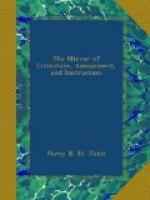Some authors have proved the mildness and docility of the camelopard, while others represent it as incapable of being tamed. This difference is ascribed by M. Saint-Hilaire to difference of education. Four or five years ago a male Giraffe, extremely savage, was brought to Constantinople. The keeper of the present Giraffe had also the charge of this one, and he ascribes its savageness entirely to the manner in which it was treated. At the same time M. Mongez read a memoir on the testimony of ancient authors respecting the Giraffe. Moses is the first author who speaks of it. As Aristotle does not mention it, M. Mongez supposes that it was unknown to the Greeks, and that it did not then exist in Egypt, otherwise Aristotle, who travelled there, must have known about it. In the year 708 of Rome, Julius Caesar brought one to Europe, and the Roman emperors afterwards exhibited them at Rome, either for the games in the circus, or in their triumphs over the African princes. Albertus Magnus, in his Treatise de Animalibus, is the first modern author who speaks of the Giraffe. In 1486, one of the Medici family possessed one at Florence, where it lived for a considerable time.
In its native country the Giraffe browses on the twigs of trees, preferring plants of the Mimosa genus; but it appears that it can without inconvenience subsist on other vegetable food. The one kept at Florence fed on the fruits of the country, and chiefly on apples, which it begged from the inhabitants of the first storeys of the houses. The one now in Paris, from its having been accustomed in early life to the food prepared by the Arabs for their camels, is fed on mixed grains bruised, such as maize, barley, &c., and it is furnished with milk for drink morning and evening. It however willingly accepts fruits and the branches of the acacia which are presented to it. It seizes the leaves with its long rugous and narrow tongue by rolling it about them, and seems annoyed when it is obliged to take any thing from the ground, which it seems to do with difficulty. To accomplish this it stretches first one, then the other of its long fore-legs asunder, and it is not till after repeated attempts that it is able to seize the objects with its lips and tongue.
The pace of the Giraffe is an amble, though when pursued it flies with extreme rapidity, but the small size of its lungs prevents it from supporting a lengthened chase. The Giraffe defends itself against the lion, its principal enemy, with its fore feet, with which it strikes with such force as often to repulse him. The specimen in the museum at Paris is about two years and a half old.
The name Camelo-pardalis (camel-leopard) was given by the Romans to this animal, from a fancied combination of the characters of the camel and leopard; but its ancient denomination was Zurapha, from which the name Giraffe has been adopted.—Brewster’s Journal.
Sugar.




